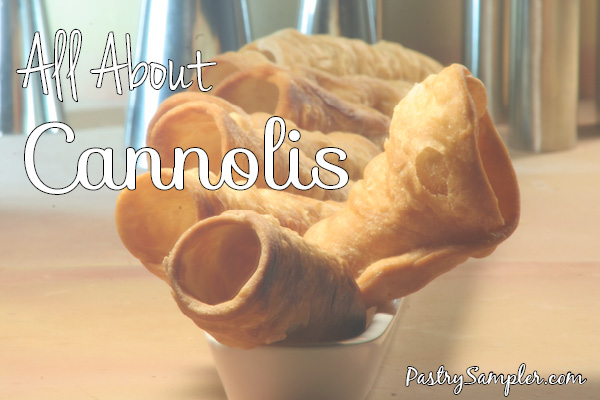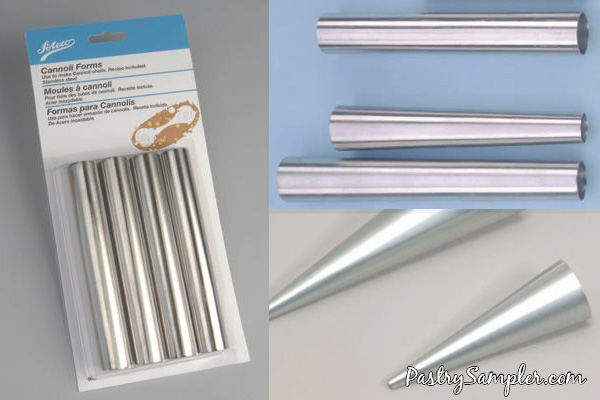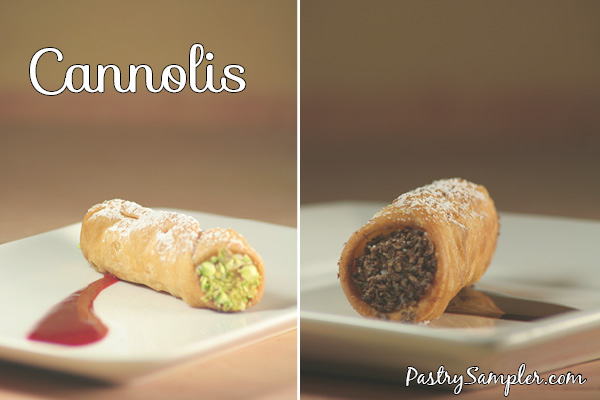All About Cannolis
By Renee
Shelton


Cannolis
are an Italian specialty: a crisp tube filled with a sweetened
ricotta cream. Mousses or sweetened whipped cream can also
be used for the filling. Cannolis are made with a dough usually
containing a wine, sweet or otherwise, and rolled around a cylinder
and fried in hot oil.
Cannolis
are typically tube shaped, but cream horn molds can also be used. Sizes for cannoli molds come in mini, finger-sized or very large.
Once they are fried, will keep for about a week in a tightly
covered container. They can be 'refreshed' by placing in a 350°F
oven for a couple of minutes to crisp again, but cannolis are always best
served fresh.
Almost
every recipe of cannoli dough will contain a wine inside of
it. This provides not only flavor, and sometimes color and aroma,
but gives the necessary acid to help in softening the gluten.
This dough will be quite stiff and requires kneading for development.
It helps to rest the dough before rolling it out. And when it comes time to roll
it out, it is important to roll it as thinly as possible. When it isn't,
the cannolis will end up a thick, greasy fried tubes, instead of
the light filling holder it's meant to be. Besides, as they
are frying, they tend to puff up a bit and the outside blisters giving it their characteristic surface. The thinner doughs show off this characteristic better.
The cylinder molds come in a variety of diameters, either in equal diameters on each end, or where one end is slightly larger than the other giving just a hint of a cone appearance. Cream horn molds are easily used with cannolis. These are cone shaped molds that give them an ice cream cone shape, which are great for portability for large parties or stacking them together with the pointed ends pointing to the center on the dessert table.

The traditional
filling is a sweetened ricotta cheese that is sometimes mixed with candied
orange zest or citron, chopped pistachios, grated chocolate, and flavored
with a variety of extracts or flavorings such a fortified wine and liqueurs.
The ends may be decorated with what the filling is to give color and
texture, such as dipping the ends in chopped pistachios if pistachios
were used for the filling. The filling may also be left plain and the
ends used for decoration. While a sweetened ricotta is traditionally
used, any pipable soft filling may be used: chocolate or fruit mousses, whipped cream, cream cheese or mascarpone filling.

Renee's Tips and Notes for Cannolis:
- Always fill á
la minute, right before service, to keep the cannoli shells crisp.
- Cannolis will
keep for about a week if kept tightly covered. And while they are best served
fresh, they make a delicious make ahead dessert that is portable.
- My favorite filling
is simply sweetened ricotta: pick out a ricotta cheese and sweeten
to taste with powdered sugar. If the cheese is too soft, drain overnight
to firm up.
- You will find
cannoli dough with a varying list of ingredients, from sweet wine
to dry white, with eggs or without, with melted butter or softened butter.
Each will play a role in the finished product making each cannoli shell recipe slightly different from the next. The advantage to
having eggs in the dough is that it may be easier to knead and roll out; the
advantage to having no eggs in the dough is that it can sit to be
rested at room temperature.
- Read the procedures
well as some recipes need more kneading than others.
- Since the dough
will become tough if rerolled, roll out thinly (usual recipes call
for 1/16" thick), and cut out as many as you can the first time using the right
sized cutter or sharp knife.
- Cannoli dough
can be cut into circles for forming around the molds, or into squares.
Each shape will give a different end look for the cannoli.
- After cutting out the
shapes, use a rolling pin to slightly make them elongated which aids in attaching them to the cannoli forms.
- When forming them around the molds, it will help use forms that are very lightly
oiled (I brush my hands with some oil and rub the molds with that
thin layer from my hands). This will help them slide off easily after frying.
Only the first batch needs to be oiled as subsequent batches will
already have a thin layer from frying.
- Seal them with
a bit of egg wash: fold over one end and using a finger rub a small
amount of beaten egg on the part that will overlap. Press to seal.
- When removing
from the hot oil after frying, remove while they are still hot. If they are too hot to handle place on cloth or paper toweling and let cool only barely, then gently
remove from the cannolis from their molds. If the cannoli shells are left to cool completely on the
forms, they may be difficult to remove, and they can break during removal. Always remove while they are still warm.
- Use a frying thermometer. This will help you regulate the
heat source to keep the oil at the optimum temperature as required
by the individual recipe.
- And since the dough doesn't like to be reworked, use the scraps as a snack. The scraps of
cannoli dough are great for frying up and sprinkling with powdered
sugar; good for when children desperately want to taste one of the
finished unfilled cannolis that you have reserved for your event. Note: this applies to the makers as well. :)
Cannoli Recipes
Cannoli
Dough (no egg version)
This is my favorite recipe for
cannolis, and is one I created. It creates a nicely colored dough, and
pairs well with a multitude of fillings. If making ahead, simply wrap
after kneading, place in cooler, and allow it to come to room temperature
before rolling. This contains no eggs.
1 1/2 cups flour
1 1/2 tablespoons sugar
1/4 teaspoon salt
1 1/2 tablespoons unsalted butter, melted
7 tablespoons Marsala (no substitutions)
Place flour in a
bowl and sprinkle with sugar and salt. Stir in the butter and the Marsala
until a dough forms. Transfer to a work surface and knead the dough
until smooth, about 5 to 10 minutes. Let rest on counter for about a
half an hour before rolling out. This dough also can be chilled overnight
for advance preparation; simply allow to come to room temperature before
rolling. When ready for rolling, cut dough in half and roll out very
thin. Cut into desired sized shapes and roll around cannoli forms. Fry
a few at a time in hot oil (350°F) until browned and done. Carefully
remove from the oil and allow to cool slightly before removing from
the molds. Cool completely and use immediately, or allow to cool and
wrap tightly for later use.
_________________________
Cannoli
Dough (Sauternes or white wine recipe)
This recipe is adapted from the Ateco
Cannoli recipe. It contains eggs, firm butter and Sauternes or similar
white wine. Visit these links for a description between Sauternes and Sauterne, from
Wikipedia.
1 3/4 cups flour
2 tablespoons sugar
1/2 teaspoon salt
1 egg, beaten
2 tablespoons firm butter, cut into small pieces
1/4 cup Sauternes, Sauterne or similar white wine
Sift flour with
sugar and salt into a bowl. Add in egg and butter. Mix, adding in the
wine a little at a time until a dough forms. Form into a ball and cover
for 15 minutes. Roll out dough on a lightly floured surface until thin
and cut out into desired sizes for the cannoli molds. Wrap around the
molds and seal up. Fry in 350°F oil a few at a time until golden,
and remove carefully to toweling. Cool slightly and slip the cannolis
from the molds. Allow to cool completely and fill as desired.
_________________________
Cannoli
Dough (simple version)
This dough contains only three ingredients:
flour, Marsala and a bit of sugar. After kneading, let rest for about
2 hours. Adapted from 'Cannoli alla Siciliana' recipe from Pies and
Pastries from The Good Cook series.
2 cups flour, sifted
1/4 cup Marsala
1 tablespoon sugar
Pinch of salt
With the flour,
make a mound on a work surface with a well in the center. Sprinkle the
sugar and salt and add in the wine. Knead well for about 15 minutes
until the dough is smooth. Lightly wrap the kneaded ball with a damp
cloth and let the dough rest for two hours at room temperature. Roll
out thinly, cut out shapes, and roll around the cannoli forms. Deep
fry in hot oil, 390°F, a few at a time and remove when golden brown.
Remove and drain on toweling, allow to cool slightly and carefully remove
the cannoli forms. Allow to cool completely and fill as desired.
References
used:
Editors
of Time Life Books. Pies & Pastries. The Good Cook Techniques
& Recipes. Alexandria: Time Life, 1981.
Recipes from
the files of Renee Shelton.
Ateco recipe
adapted from back of the Ateco Cannoli Forms.
"Sauternes
(wine)." Wikipedia, The Free Encyclopedia. 30 Dec 2006,
02:04 UTC. Wikimedia Foundation,
Inc. Site accessed 16 Feb 2007. <http://en.wikipedia.org/w/index.php?title=Sauternes_%28wine%29&oldid=97254564>
"Sauterne." Wikipedia, The Free Encyclopedia. 6 Sep 2006, 09:26 UTC. Wikimedia
Foundation, Inc.
Site accessed 16 Feb 2007 <http://en.wikipedia.org/w/index.php?title=Sauterne&oldid=74102990>.
Renee Sheltonon

|


